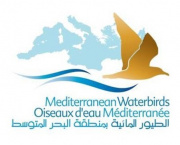

Why a Mediterranean Waterbirds Network?
Created in 2012, the Mediterranean Waterbirds Network (MWN) brings together different partners (local and international NGOs, universities, administrations, etc.) involved in the monitoring and the protection of waterbirds and wetlands in the Mediterranean region, with the aim of reinforcing the monitoring of waterbirds and wetland conservation.
Why waterbirds?
Waterbirds are an important component of Mediterranean wetlands. Their diversity, abundance and migration habits are important for many of our cultural values and human social practices. These species are since long time subject of monitoring, helping to evaluate and understand the value and health of wetlands ecosystems. Waterbirds are also an excellent way to raise awareness and mobilize civil society for their conservation and that of the ecosystems on which they depend.
The results of the waterbird monitoring are directly used in the implementation of the international initiatives, such as the Ramsar convention and the African-Eurasian waterbird Agreement (AEWA).
How does MWN work to achieve its goals?
The Mediterranean Waterbirds Network was initiated in 2012 by five North African countries , but since 2017 other Mediterranean countries are part of the network, including France (LPO France), Spain (SEO BirdLife), Italy (ISPRA), Greece (HOS-BirdLife Greece), Turkey (ORC), but also Portugal, Albania, Serbia, Montenegro and Northern Macedonia.
The MWN has been coordinated since 2012 by the Tour du Valat, the Office français de la biodiversité (OFB, ex ONCFS) in collaboration with Wetlands International. The Ministère de la Transition écologique et de la Cohésion des territoires has been MWN's historic financial contributor, along with MAVA, but several financial partners have helped to support the network, as well as the development of additional activities (see details of technical and financial partners HERE).
It aims to improve the spatial coverage and the overall quality of waterbird monitoring by:
- Supporting the International Waterbirds Census (IWC)
- Creating synergies between existing programs
- Strengthening national networks of observers
- Completing the inventory of wetlands
IWC reports and count data distribution
Click here to find the reports prepared as a syntheses of the IWCs realised between 2009 and 2018 in 10 of the countries part of the MWN, and check this map to see the distribution of count data in the Mediterranean.
Download the flyer of the network.
Would you like to stay updated on the latest activities of the Mediterranean Waterbirds Network? Check out the Medwaterbirds facebook page!
Photo credits and species names from top to bottom:
Eurasian Whimbrel (Numenius phaeopus); Squacco Heron (Ardeola ralloides); Eurasian Oystercatcher (Haematopus ostralegus): ©Thomas Blanchon. | Great Egret (Ardea alba): Julien Birard. | Ruddy Duck (Oxyura jamaicensis): ©Thomas Galewski | Greater Flamingo (Phoenicopterus roseus): ©Marta Lago | Ruddy Turnstone (Arenaria interpres) with Gull sp.: ©Julien Birard. | Great Cormorant (Phalacrocorax carbo): ©Thomas Galewski.






